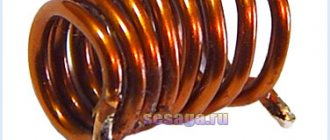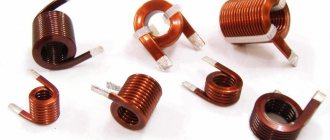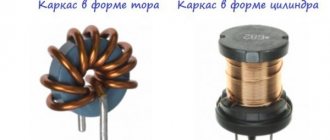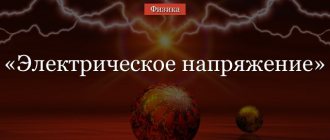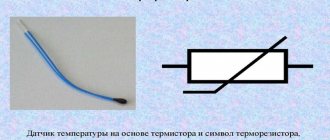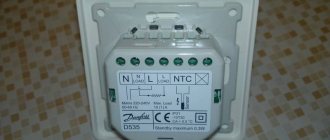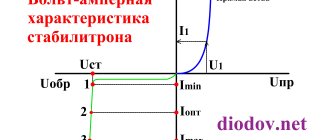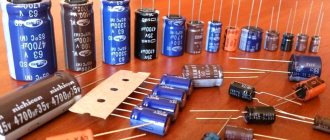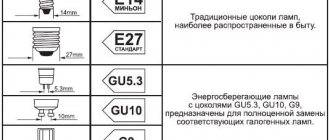Hello, dear readers of the site. An inductor is one of the elements without which it would be impossible to build a receiver, TV, radio-controlled model, transmitter, signal generator, modem converter, surge protector, etc.
An inductor or simply a coil can be thought of as several turns of wire wound in a spiral. The current passing through each turn of the spiral creates a magnetic field in them, which, intersecting with neighboring turns, induces self-induction emf in them. And the longer the wire and the greater the number of turns it forms, the greater the self-induction.
Inductance
At its core, inductance is electrical inertia.
and its main property is to
resist any change in the flowing current
.
If a certain current is passed through the coil, its inductance will counteract
both the decrease and the increase in the current flowing.
Unlike a capacitor, which allows alternating current to pass but not direct current, an inductor allows direct current to pass freely and resists alternating current because it changes faster than the magnetic field can change.
And the greater the inductance of the coil and the higher the frequency of the current, the stronger the resistance. This property of the coil is used, for example, in receiving equipment, when it is necessary to block the path of alternating current in an electrical circuit.
Inductance is measured in henry
(H),
millihenry
(1 mH = 10ˉ3 Hn),
microhenry
(1 μH = 10ˉ6 Hn),
nanohenry (
1nHn = 10ˉ9 Hn) and is designated by the Latin letter
L.
Current limiting reactor
Modern dry current-limiting reactors at Noxon Rapids 230 kV Dam
A current-limiting reactor is an electrical device designed to limit the shock current of a short circuit. It is connected in series to a circuit whose current needs to be limited, and works as an inductive (reactive) additional resistance that reduces the current and maintains the voltage in the network during a short circuit, which increases the stability of generators and the system as a whole.
General properties of inductors
Depending on the required inductance and the frequency at which the coil will operate, it can have a variety of designs.
For high frequencies, this can be a simple coil consisting of several turns of wire or a coil with a core made of ferromagnetic material and have an inductance from several nanohenries to several tens of millihenries. Such coils are used in radio receiving, transmitting, measuring equipment, etc.
Coils operating at high frequencies can be divided into circuit coils
,
coupling coils
and
high frequency chokes
.
In turn, the coils of the circuits can be with constant inductance
and
variable inductance
(variometers).
By design, high-frequency coils are divided into single-layer and multilayer, shielded and unshielded, coils without cores and coils with magnetic and non-magnetic cores, frameless, cylindrical flat and printed.
To operate in low-frequency alternating current circuits, at audio frequencies, in input filters of power supplies, and in power circuits of lighting electrical equipment, coils with a sufficiently high inductance are used. Their inductance reaches tens and even hundreds of henries, and large voltages can be created in the windings and significant currents can flow.
To increase the inductance in the manufacture of such coils, magnetic circuits (cores) are used, assembled from individual thin insulated plates made of special magnetic materials - electrical steels, permalloys, etc.
The use of stacked magnetic cores is due to the fact that under the influence of an alternating magnetic field, eddy currents are formed in a solid magnetic core, which can be considered as many short-circuited turns, which heat the magnetic core, uselessly consuming part of the magnetic field energy. The insulation between the layers of steel is in the path of eddy currents and significantly reduces losses.
Coils with magnetic cores made of insulated plates can be divided into chokes
and
transformers
.
Terminology
When used to suppress interference, smooth out electrical current ripples, isolate (high frequency) different parts of a circuit, and store energy in the core's magnetic field, it is often called an inductor .
In power electrical engineering (to limit the current during, for example, a short circuit of a power line) it is called a reactor .
A cylindrical inductor whose length is much greater than its diameter is called a solenoid ; the magnetic field inside a long solenoid is uniform. In addition, a solenoid is often called a device that performs mechanical work due to a magnetic field when a ferromagnetic core is retracted, or an electromagnet . In electromagnetic relays they are called a relay winding , or less commonly an electromagnet.
A heating inductor is a special inductor coil, a working element of induction heating installations.
When used for energy storage it is called induction storage .
Basic parameters of inductors
The properties of coils can be characterized by four main parameters: inductance
,
quality factor
,
intrinsic capacity
and
stability
.
Inductance.
Inductance
(
self-induction coefficient
) is the main electrical parameter and characterizes the amount of energy stored by the coil when electric current flows through it. The greater the inductance of the coil, the more energy it stores in its magnetic field.
Inductance depends on the size of the frame, shape, number of turns of the coil, diameter and grade of wire, as well as on the shape and material of the magnetic circuit (core).
In amateur radio circuits, as a rule, the inductance value is not indicated, since the radio amateur is not interested in this value, but in the number of turns of wire in the coil, the diameter and grade of the wire, the method of winding (in bulk, turn to turn, cross to cross, sectional winding) and dimensions coil frame.
Good quality.
Quality factor
(
Q
) is characterized by the quality of the inductor in AC circuits and is defined as the ratio of the reactance of the coil to its
active loss resistance
.
Active resistance includes the resistance of the coil winding wire; resistance introduced by dielectric losses in the frame; resistance introduced by its own capacitance and resistance introduced losses in screens and cores.
The less
active resistance, the
higher
the quality factor of the coil and its quality. In most cases, the quality factor of the coil is determined by the resonant properties and efficiency. contour. Modern medium-sized coils have a quality factor of about 50 - 300.
Own capacity.
Inductors have their own capacitance
, which increases as the number of turns and coil sizes increase.
Between adjacent turns there is interturn capacitance
, due to which some of the current does not pass through the wire, but through the capacitance between the turns, causing the resistance between the coil terminals to decrease.
The thing is that the total voltage applied to the coil is divided into interturn voltages, due to which an electric field is formed between the turns, causing an accumulation of charges. The turns, separated by layers of insulation, form the plates of many small capacitors through which part of the current flows, from the total capacitance of which the coil’s own capacitance is formed. Thus, the coil has not only inductive but also capacitive properties.
Self-capacitance is a harmful parameter and they strive to reduce it by using special frame shapes and wire winding methods.
Stability.
Stability
coil is characterized by changes in its parameters under the influence of temperature, humidity and time.
The change in inductance under the influence of temperature is characterized by the temperature coefficient of inductance (TCI), equal to the relative change in inductance with a temperature change of 1°C. The TCI of the coil is determined by the winding method and the quality of the frame dielectric.
Humidity
causes an increase in its own capacitance and dielectric losses, and also reduces the stability of the coil. To protect against moisture, sealing or impregnation and enveloping of the winding with non-hygroscopic compounds is used.
Such coils have a lower quality factor and a large intrinsic capacity, but they are more resistant to moisture.
see also
- Solenoid
- Ruhmkorff coil, ignition coil
- Pupin Coil
- Erokhin coil
- Ferrite filter
- Transformer
- Electrical impedance
- Transient process (electronics)
- resistor, variable resistor, trimming resistor, varistor,
- memristor, pizastor, fourth passive element of electrical engineering,
- electric capacitor, capacitor, capacitors, variable capacitor,
I wrote an article about inductors especially for you. If you would like to contribute to the development of theory and practice, you can write a comment or send an article to my email in the contacts section. By doing this you will help other readers, because this is what you want to do? I hope that now you understand what an inductance coil is, inductance, types of inductance, inductance characteristics and why all this is needed, and if you don’t understand, or have any comments, then don’t hesitate to write or ask in the comments, I will be happy to answer. In order to gain a deeper understanding, I strongly recommend that you study all the information from the category Electronics, Microelectronics, Component Base
Inductors with magnetic cores
Magnetic cores are used to produce small-sized coils for various purposes.
(cores), which are made from
magnetodielectrics
and
ferrites
. Coils with magnetic cores have a smaller number of turns for a given inductance, short wire length and small dimensions.
A valuable property of coils with magnetic cores is the ability to adjust them, i.e. changes in inductance within small limits by moving a special cylindrical trimmer inside the coil, consisting of ferrite with a threaded bushing pressed onto it.
Magnetodielectrics
They are a crushed substance containing iron (ferromagnetic), the particles of which are evenly distributed in the mass of the dielectric (bakelite or aminoplast). The most widely used magnetic cores are made of alsifer (an alloy of aluminum, silicon and iron) and carbonyl iron.
Ferrites
They are solid solutions of metal oxides or their salts that have undergone special heat treatment (firing).
The resulting substance - semiconductor ceramics
- has very good magnetic properties and low losses even at very high frequencies.
The main advantage of ferrites is their high magnetic permeability, which makes it possible to significantly reduce the size of the coils.
In old circuit diagrams, magnetic cores made of magnetodielectrics and ferrites were designated the same way - with a thick dashed line
(Fig. a).
Subsequently, the ESKD standard left this symbol for magnetic cores made of magnetodielectric, and for ferrite ones it introduced a designation that was previously used only for magnetic cores of low-frequency chokes and transformers - a solid thick line
(Fig. b).
However, according to the latest edition of GOST 2.723.68 (March 1983), the magnetic circuits of the coils are depicted by lines of normal thickness
(Fig. c).
Coils, the inductance of which can be changed using a magnetic circuit, are indicated on electrical diagrams using a tuning control sign
, which is introduced into its symbol.
A change in inductance is indicated in two ways: either by a tuning control sign crossing the designations of the coil and magnetic circuit (Fig. a), or only by crossing the magnetic circuit with its image above the coil (Fig. b).
Color marking of chokes
In this article we will talk about determining the parameters of chokes using the table of color markings of chokes. The color marking of the chokes practically coincides with the color marking of the inductors. The structure of the chokes markings is as follows:
- the first two marks (stripes or dots) indicate the value of the nominal inductance in microhenry (µH);
- the third mark is the multiplier;
- the fourth mark is tolerance.
Most often, 4 or 3 colored stripes or dots are used to mark chokes. When using throttle markings with three marks, the default assumes a 20% tolerance. Let's look at examples of how the main parameters of chokes are determined.
Color coding of chokes.
Shielded inductors
To eliminate parasitic connections caused by the external electromagnetic field of the coil and the influence of the surrounding space on the coil, it is shielded, i.e. placed in a closed metal screen
.
However, under the influence of the screen, the main electrical parameters of the coil change: inductance and quality factor decrease, resistance and self-capacitance increase.
The closer the screen is located to its turns, the greater the change in coil parameters, i.e. the change in parameters depends on the relationship between the dimensions of the coil and the dimensions of the screen itself.
For high-frequency coils, screens are made in the form of round or rectangular glasses made of aluminum, copper or brass with a wall thickness of 0.3 - 0.5 mm.
To indicate a shielded coil in the diagrams, its symbol is placed in a shielding sign, which is connected to the housing.
It should also be noted that only large coils with a diameter of more than 15 - 20 mm need to be shielded.
Coils with a diameter of no more than 4 - 5 mm create a magnetic field in a relatively small space and when such coils are removed from other parts at a distance of 4 - 5 times their diameter, as a rule, dangerous connections do not arise, so they do not require special shielding.
Types of reactors
Current-limiting reactors are divided into:
- by installation location: external and internal;
- by voltage: medium (3 -35 kV) and high (110 -500 kV);
- by design: concrete, dry, oil and armored;
- by phase arrangement: vertical, horizontal and stepped;
- by winding design: single and double;
- by functional purpose: feeder, group feeder and intersectional.
Concrete reactors
They have become widespread in indoor installations for network voltages up to 35 kV inclusive. The concrete reactor consists of concentrically arranged turns of insulated stranded wire cast into radially arranged concrete columns. During short circuits, the windings and parts experience significant mechanical stresses caused by electrodynamic forces, so high-strength concrete is used in their manufacture. All metal parts of the reactor are made of non-magnetic materials. In case of high currents, artificial cooling is used.
The phase coils of the reactor are arranged so that when the reactor is assembled, the fields of the coils are located in opposite directions, which is necessary to overcome longitudinal dynamic forces during a short circuit. Concrete reactors can be made with either natural air or forced air cooling (for large rated powers), the so-called. “blown” (the letter “D” is added to the marking).
As of 2014, concrete reactors are considered obsolete and are being replaced by dry reactors.
Three-phase current-limiting reactor in a 110 kV line, rated reactive power 50 Mvar
Oil reactors
Used in networks with voltages above 35 kV. The oil reactor consists of windings of copper conductors, insulated with cable paper, which are laid on insulating cylinders and filled with oil or other electrical dielectric. The liquid serves as both an insulating and cooling medium. To reduce heating of the tank walls from the alternating field of the reactor coils, electromagnetic screens and magnetic shunts are used.
The electromagnetic shield consists of short-circuited copper or aluminum turns located concentrically with respect to the reactor winding around the walls of the tank. Shielding occurs due to the fact that an electromagnetic field is induced in these turns, directed counter and compensating the main field.
A magnetic shunt is a package of sheet steel located inside the tank near the walls, which creates an artificial magnetic circuit with a magnetic resistance lower than that of the tank walls, which causes the main magnetic flux of the reactor to close along it, and not through the walls of the tank.
To prevent explosions associated with overheating of the oil in the tank, according to the PUE, all reactors with voltages of 500 kV and higher must be equipped with gas protection.
Dry reactors
Dry reactors belong to a new direction in the design of current-limiting reactors and are used in networks with rated voltages up to 220 kV. In one of the design options for a dry reactor, the windings are made in the form of cables (usually rectangular in cross-section to reduce size, increase mechanical strength and service life) with silicone insulation, wound on a dielectric frame. In another reactor design, the winding wire is insulated with a polyamide film, and then with two layers of glass filaments with sizing and impregnation with silicone varnish and subsequent baking, which corresponds to heat resistance class H (operating temperature up to 180 ° C); pressing and tying the windings with bands makes them resistant to mechanical stress during shock current.
Armor reactors
Despite the tendency to manufacture current-limiting reactors without a ferromagnetic magnetic core (due to the danger of saturation of the magnetic system at short-circuit current and, as a consequence, a sharp drop in current-limiting properties), enterprises manufacture reactors with armored cores made of electrical steel. The advantage of this type of current-limiting reactor is its smaller weight, size and cost (due to the reduction in the proportion of non-ferrous metals in the design). Disadvantage: the possibility of loss of current-limiting properties at shock currents greater than the nominal value for a given reactor, which in turn requires careful calculation of short-circuit currents. in the network and selecting an armored reactor in such a way that in any network mode the short-circuit shock current did not exceed nominal.
Twin reactors
Twin reactors are used to reduce the voltage drop in normal mode, for which each phase consists of two windings with strong magnetic coupling, connected in opposite directions, each of which is connected to approximately the same load, as a result of which the inductance is reduced (depending on the residual differential magnetic field). With short circuit in the circuit of one of the windings the field increases sharply, the inductance increases and the process of current limitation occurs.
Intersectional and feeder reactors
Intersectional reactors are switched on between sections to limit currents and maintain voltage in one of the sections during a short circuit. in another section. Feeder and feeder group feeders are installed on outgoing feeders (group feeders are common to several feeders).
Designation of coils with taps and the beginning of the winding
In radio and electrical equipment, for example, in receivers or pulse voltage converters, sometimes not the entire inductance of the coil is used, but only some of it. For such cases, the coils are made with a tap or taps.
When developing certain designs, it is sometimes necessary to strictly observe the beginning and end of the winding of a coil or transformer. To indicate which end of the winding is the beginning and which is the end, a bold dot is placed at the terminal of the beginning of the winding.
To tune coils at frequencies above 15...20 MHz, magnetic cores made of non-magnetic materials (copper, aluminum, etc.) are often used. The eddy currents arising in such a magnetic circuit under the influence of the magnetic field of the coil create their own field, counteracting the main one, as a result of which the inductance of the coil decreases.
A non-magnetic magnetic trimmer is designated in the same way as a ferrite one, but the chemical symbol of the metal from which it is made is indicated next to it. The picture shows a trimmer made of copper.
That's all I wanted to tell you about inductors . Good luck!
Literature: 1. V. A. Volgov “Parts and components of radio-electronic equipment.” 2. V.V. Frolov “The language of radio circuits.” 3. M. A. Sgut “Symbols and radio circuits.”
Application of reactors
During a short circuit, the current in the circuit increases significantly compared to the normal mode current. In high-voltage networks, short-circuit currents can reach such values that it is not possible to select installations that could withstand the electrodynamic forces arising from the flow of these currents. To limit the short circuit current, current-limiting reactors are used, which during short circuit. They also maintain a sufficiently high voltage on the power busbars (due to a larger drop in the reactor itself), which is necessary for the normal operation of other loads.
Symbol for single and double reactors
